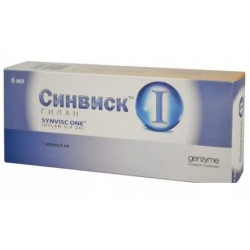



 All payments are encrypted via SSL
All payments are encrypted via SSL
 Full Refund if you haven't received your order
Full Refund if you haven't received your order
Synvisk I / Synvisc One (Hylan G-F20) is a sterile, pyrogen-free, viscoelastic fluid containing Hylans. Hylans are derivatives of hyaluronan (sodium salt of hyaluronic acid) and consist of repeating disaccharide units of N-acetylglucosamine and sodium glucuronate. Hylan G-F20 contains Gilan A and Gilan B (8.0 mg and 2.0 mg in 1 ml), diluted in physiological sodium chloride solution. The average molecular weight of guilan A is about 6 million daltons. Gilan B is a hydrated gel.
Hylan G-F20 is a biological analogue of hyaluronan, which is a component of the synovial fluid causing its viscoelastic properties. However, the mechanical (viscoelastic) properties of Hylan G-F20 are superior to those of synovial fluid and hyaluronan solutions in comparable concentrations.
Synvisc I / Synvisc One is intended only for intra-articular injection by a physician for the treatment of pain caused by osteoarthritis of the knee joint.
Synvisk I / Synvisc One (Hylan G-F20)
- temporarily replaces and replenishes synovial fluid;
- effective in patients at all stages of the development of pathology of the knee joint;
- most effective in patients with active and regular load on the affected knee joint;
- The therapeutic effect is achieved by “restoring viscosity”, thanks to which the rheological properties of the synovial fluid and the physiological and rheological properties of the tissues of the joint affected by osteoarthrosis are restored.
Restoration of viscosity with Hylan G-F20 is a treatment aimed at reducing pain and discomfort, allowing for more extensive movement of the joints. In vitro studies have shown that Hylan G-F20 protects cartilage cells from certain physical and chemical damage.
The effect of using Synvisc I / Synvisc One applies only to the affected joint. Synvisk I / Synvisc One has no overall effect.
Data from prospective clinical studies of patients with osteoarthritis of the knee joint have demonstrated the effectiveness of using Synvisc I / Synvisc One for up to 52 weeks after a single injection.
- Do not insert Synvisc I / Synvisc One into the knee joint in the presence of venous or lymphatic stasis of the limb.
- Do not insert Synvisc I / Synvisc One into an infected or severely inflamed knee, or use in patients with skin lesions or infections in the immediate vicinity of the injection site.
- Do not insert Synvisc I / Synvisc One into the knee joint in the presence of venous or lymphatic stasis of the limb.
- Do not insert Synvisc I / Synvisc One into an infected or severely inflamed knee, or use in patients with skin lesions or infections in the immediate vicinity of the injection site.
- Do not administer Synvisc I / Synvisc One if there is a significant intra-articular effusion immediately before the injection.
- As after any invasive procedure into the joint, after an injection the patient is advised to avoid strong physical exertion, gradually restoring normal activity over several days.
- Studies using Synvisc I / Synvisc One in pregnant women and children and adolescents under 18 years of age were not conducted.
- Synvisk I / Synvisc One contains a small amount of chicken protein, therefore, in the treatment of patients with hypersensitivity to chicken protein, caution should be exercised.
- After the intra-articular injection of Synvisc I / Synvisc One from the side of the knee into which the injection was made, the following side effects may occur: short-term pain and / or edema and / or articular effusion. The post-marketing experience with Synvisc I / Synvisc One has shown that in some cases, joint effusion can be significant and cause more prolonged pain. In these cases, it is necessary to make a puncture of the joint and removal of exudate with its subsequent analysis to exclude infection and microcrystalline arthropathy. Usually such reactions disappear without a trace within a few days. The presence of such reactions does not affect the effectiveness of treatment. None of the clinical studies of Synvisc I / Synvisc One and Synvisc / Synvisc showed the development of intra-articular infections, and the occurrence of intra-articular infections in the clinical studies of Synvisc / Synvisc was rarely reported.
- The post-marketing experience revealed the following systemic reactions, which were rarely seen with the introduction of Synvisc / Synvisc rash, urticaria, itching, nausea, headache, dizziness, chills, muscle cramps, paresthesia, peripheral edema (including on the face), weakness, difficulty breathing, redness of the skin.
- In a controlled clinical trial, it was found that the incidence and type of side effects in the group of patients who received Synvisc I / Synvisc One and in the group who received placebo were similar.
Recommended mode of application Synvisk I / Synvisc One one injection into the knee joint.
Repeated injection, if necessary, can be entered 6 months after the first.
- Before the injection of Synvisc I / Synvisc One, synovial fluid or exudate should be removed.
- Synvisk I / Synvisc One should be administered at room temperature, in strict accordance with the rules of asepsis, especially when removing the protective cap from the syringe.
- Synvisk I / Synvisc One should be entered strictly into the synovial space, using, if necessary, fluoroscopic determination of the direction of the injection.
- When using fluoroscopy, an ionic or non-ionic contrast agent can be used to determine the direction of the injection. For every 2 ml of Synvisc I / Synvisc One no more than 1 ml of contrast material should be used.
- Use the appropriate length and size (18-22) of the needle.
The contents of the syringe is sterile and pyrogen-free.Store at a temperature of +2aboutC to +30aboutC. Do not freeze.
